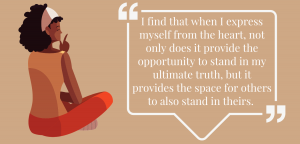
I have recently gotten into studying yoga mythology and am having a wonderful time not only tying these myths to my asana practice but also to life off of the mat.
Recently, I finished the Ramayana, an epic that I’ve heard in bits and pieces throughout my 10-year yoga teaching career. Most of us, (especially those fortunate enough to study with Amy Ippoliti in her advanced philosophy training), are familiar with the stories of Sita, Rama and Hanuman. They are beautiful, but, for me, it was the stories in between that captured me. The story of Guha was one such story.
Like any truly great myth or story, the Guha episode can be viewed from many different angles and reveal any number of things about who we are, who we can be, or who we could be.
In this article, my focus will be on commitment and authenticity.
Most of us know about Hanuman’s devotion, but how many of us pause at Guha’s commitment to his own heart?
Devotion, in many respects is easy, we are devoted because we love, and devotion is often extended to those that are also devoted to us: family, pets, friends and deities.
Commitment is something more: commitment is something that is not always made from a place of love but instead from a place of duty. Commitment is dharma.
And this is why we are committed to our partners, our jobs, our studies, our practice. We may love these people or these things but it isn’t always easy, enjoyable or even reciprocal. And in some cases it’s impermanent. In short, it takes work but if we put in that work, we can often reap benefits beyond our wildest dreams.
Guha is the Hunter King that assists Sita, Rama, and Lakshmana as they first enter the forest after Rama’s exile from Ayodhya. I won’t go too far into it, but after a night of drinking, he sits Lakshmana down and tells him his story of which I will share highlights. Of course, because this is myth, I urge you to read the full story for yourself and contemplate what lessons show up for you.
Guha’s forest is invaded by Brahmanas that want to convert him from worshipping his Sacred Tree to worshipping Shiva. He is not pleased by this persuasion and attempts to recruit him.
Your commitment is unique to you and should be respected. I can’t tell you how many times my yoga knowledge has been challenged by a student, other yoga teacher, or an acquaintance. They’ve read one book, listened to one “guru,” or studied only one school of thought and have challenged me – while I was teaching.
As enthusiastic as you might be about your style of practice or beliefs, someone else’s commitment may be to another style or set of beliefs. Our job is not to force conversion, but to model the benefits that we have achieved due to our engagement with our particular style of practice or beliefs.
Off of the mat, we will meet those with beliefs that differ from our own and instead of jumping into conversion mode, perhaps we should step back, take a deep breath, open our mind and see what we can learn from them. These beliefs range from faith traditions (or lack thereof), to political affiliations, to culture. At the end of the day, unless someone’s belief includes evil, hateful, or destructive forces that could cause harm, there is room for all points of view.
In Guha’s words, the Brahmanas are “all talk and no deeds, all words and no wisdom, and what they don’t know or think of they think does not exist.”
Once you have practiced asana long enough, you will come to realize that there are innumerable ways to enter a pose, be in a pose, or exit a pose: this wisdom is only gained from doing and studying. Talking about it alone will not help you gain clarity or advancement.
In life, how many of us post the trending memes or hashtags on social media about social justice, climate change, and equality but do nothing else once we leave our screens? Have we made a pledge to our planet by investing in reusable and eco-friendly products and driving less? Do we speak up when someone says something derogatory about marginalized people? Are we studying how to actually become anti-racist or were we only hash tagging Black Lives Matter when it was trending? Are we committed enough to be uncomfortable?
Every night, after hunting and no matter if he was hungry, exhausted or sick; Guha would kick Shiva’s statue to make it known that Shiva was not welcome in his forest.
Every day I commit to do something to further my yoga practice and improve my teaching. This could be asana practice, studying a yoga book, listening to a lecture, or assisting a training. I don’t always want to do it, but I have not only committed to yoga, I have also committed to my career. I am as passionate about it as Guha is about making it known that he wants nothing to do with Shiva!

For example, early on in my teaching career, I would wake up at 4:30 AM, cross the Capital Beltway and drive almost 20 miles from my home to teach a 6:00 AM yoga class. I’ve never been a morning person but I made this trip for 2 years. This eventually led to my subbing the class that followed it so often that that class turned into my first primetime gig at that gym. Because of my commitment, I taught four prime time classes there pre-Covid and I teach two classes for them per week now, virtually. When I think back to the days of driving pre-dawn, teaching a small but dedicated group, and establishing my reputation, I can only smile knowing that the commitment paid off.
Commitment is repetition, recognition and engagement. The only way to see the results on a micro or macro level is to do the work, every day and vow to improve and deepen your practice whatever it may be.
Recognize when you feel not so up to your practice and take note, you may just need to adjust the time of day or method (i.e. maybe meditation before asana instead of after). Finally not only engage with the like-minded but engage with those who are contrary. This can expand your learning but it can also increase your confidence in using your voice to stand up for what is right and just.
Shiva reclaims Guha’s soul from Yama, the god of death.
When you’re passionate about your commitment, your reward can come from the least expected place. Although Guha thought that he was disrespecting the great Shiva, Shiva instead peered into Guha’s heart and saw not only his passion but also his authenticity.
I find that when I express myself from the heart, not only does it provide the opportunity to stand in my ultimate truth, but it provides the space for others to also stand in theirs.
When we hold space for authenticity, we are rewarded with deeper relationships with those to whom we’re committed, our highest purpose is revealed to us, and we can delve deeper into the Self. And that is Yoga.

Julie Holly is dedicated to helping her students find their purpose (dharma) and then put it into action to become a positive force in the world. Julie came to Yoga after a near death experience, caused by unmanaged stress, and has been certified as a Yoga Teacher since 2010. To deepen her understanding of how the body moves and anatomy, she became certified as a Personal Trainer in 2014 and certified as a Cancer Exercise Specialist in 2015. Her continuous yearning for knowledge and dedication to service also led her to become certified as a Trauma Informed instructor in 2015 and in Children’s Yoga in 2019. Julie is a student of the dynamic Yoga Teacher, Amy Ippoliti and the legendary Dr. Douglas Brooks. She is also a graduate of the historic Howard University in Washington DC where she currently resides. In addition to teaching Yoga full-time, Julie is the mom of a rescue dog named Malcolm Huey.

